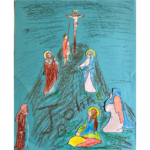
St. Rose was born in Lima, capital of Peru, on the 20th April 1586 and was baptized Isabel Flores de Oliva. She came from a large family. Her father Gaspar Flores was a soldier in the cavalry of the Imperial Spanish Army, while her mother, Maria de Oliva was a Creole.
She was such a beautiful child that for one of the servants she was simply a beautiful rose. Everybody started calling her Rosa, for rose, and that was the name she adopted at her Confirmation.
She grew up to be a beautiful young girl who attracted the attention of many. But Rosa, even when still very young, she wanted to give herself totally to God by taking a vow of virginity, determined to become a nun. But her parents aspired for her to marry, assured that her beauty would attract a good match. However, Rosa was greatly bothered by the compliments about her beauty. She cut her hair, and using pepper and lye, she tried to disfigure her face making her skin turn out in blotches!
Her parents refused to give her permission to enter a convent. With the help of her brother, she built a little grotto in their little garden and she retired there. Eventually, she received the habit of a Dominican Tertiary.
At one point, her family faced financial difficulties and to help her family out, she worked in the garden cultivating flowers to be sold at the market. She also employed herself in fine needlework, lace and embroidery to help her family financially. Very often she spent the night in prayer, lost in contemplation of the Eucharist which she received every day, a religious practice very rare in those times. She spent her days in her little grotto, fasting three days a week, abstaining from meat, wearing a hair shirt and on her head she often wore a circlet of silver that had sharp points on the inside. She even chewed bitter herbs and flogged herself!
Although she was a recluse she was not totally detached from what was happening around her. She was keenly aware of the sufferings of the people in her community, of the hardships that resulted from the corruption and practices of the Spanish lords and the governing class. She spoke openly against these oppressions in support of the missionaries who strived to ease the hardships of the natives. She was aware of the sick, the poor, the hungry homeless children, the elderly, whom she helped in every possible way, even bringing them to her home.
Rosa was often ridiculed for her way of life, especially when she started to speak of visions and ‘voices from heaven.’ Her austere way of life and severe penance had a toll on her health, so that eventually, she started suffering from ’stomach ailments, rheumatism and fevers’.
She died on the 25th August 1617, at the age of 31. Her funeral was attended by large crowds not only by the common people of Lima, but also by prominent people who took turns in carrying the coffin.












